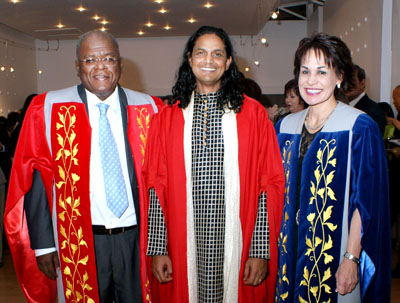Teachers should deal with diversity in education - Prof. Francis
 |
At the occasion were, from the left: Prof. Jonathan Jansen, Rector and Vice-Chancellor of the University of the Free State (UFS); Prof. Francis; and Prof. Driekie Hay, Vice-Rector: Teaching and Learning at the UFS.
Photo: Jaco van der Merwe |
Prof. Dennis Francis, the Dean of the Faculty of Education at the University of the Free State (UFS), recently delivered his inaugural lecture on Troubling Diversity in South African Education on the Main Campus in Bloemfontein.
He urged teachers to be open to what “diversity” might mean in a particular context and how diversity relates to either inclusion or exclusion.
“An approach that promotes the inclusion of all must be based on an understanding of how exclusion operates in ways that may have typical patterns of oppression, but differ in the specific ways that exclusion is expressed and becomes normalised in that context,” he said.
“The good teacher thus seeks to understand how these forms of exclusion may develop in the school’s context and respond through taking thoughtful action to challenge them. It may require creating a climate that enables the silent to speak and recognising that not all groups communicate in exactly the same ways.”
He said teachers also had to affirm the experiential base of learners and students. He said there was an assumption that students would be more effective practitioners if their own experience were validated and explored.
“It is crucial that the students’ own history is treated as valuable and is a critical part of the data that are reflected,” he said. “Equally important is that such stories and similar activities are intentionally processed to enable students to make the connections between personal experience and relevant theory.”
He also urged them to challenge the ways in which knowledge had been framed through oppression.
“Schools are often characterised by messages that draw on one or another form of oppression. Thus, expectations are subtly or in some cases unsubtly communicated, e.g. that girls are not good at physics, or that, while white learners are strong in abstract thought, African learners have untapped creativity, and so on,” he continued.
“For someone to integrate into their role as educators a commitment against oppression means confronting obstacles that one may previously have shied away from, such as challenging authority, naming privilege, emphasising the power relations that exist between social groups, listening to people one has previously ignored, and risking being seen as deviant, troublesome or unpopular.”
Furthermore, Prof. Francis said dealing with diversity in education was always affectively loaded for both students and teachers. He said in South Africa one injunction from educators was to be “sensitive” and thus avoid risking engagement with the contentious issues around imbalances of power.
“If both students and teachers are to confront issues of oppression and power in any meaningful way, we need to design more purposely for the difficulties they will encounter, for example, creating a classroom environment that promotes safety and trust so that all students are able to confront and deal with prejudice and discrimination. Classroom environments will need to balance the affective and cognitive in addressing issues of diversity and social justice,” he added.
He also said that teachers should recognise the need to complement changing attitudes with attempts to change the structural aspects of oppressions.
“To prevent superficial commitments to change, it is important for students to explore barriers that prevent them from confronting oppressive attitudes and behaviours. In this way students are able to learn and see the structural aspects of oppression,” he said.
“Equally important, however, is to get students to examine the benefits associated with challenging oppression. A fair amount of time must therefore be spent on developing strategies with students which they will be able to use practically in challenging oppression.”
He also advised educators to affirm the capacity of staff and learners to act and learn in ways that do not replicate patterns of oppression.
“Many South African schools have survived both the harsh repression of apartheid and the continuing legacy of oppression of various kinds. Despite that, we are often as educators made aware of the ways in which young people in particular affirm themselves and each other in creative and confident ways,” he concluded.
Media Release
Issued by: Lacea Loader
Director: Strategic Communication (acg)
Tel: 051 401 2584
Cell: 083 645 2454
E-mail: loaderl@ufs.ac.za
7 October 2010